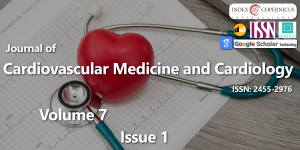Risk stratification to guide management in cardiogenic shock due to acute myocardial infarction. An illustrative case series and review of the literature
Main Article Content
Abstract
In patients who sustain an Acute Myocardial Infarction (AMI), Cardiogenic Shock (CS) is the most common cause of inpatient death. Despite significant advances in medical and surgical management, mortality rates approaching 80% have been described in some cohorts. However, the severity of CS and outcomes after AMI vary widely. Management requires a rapid, well-organised response and accurate risk stratification must guide complex decisions on ceilings of therapy in the acute setting. Whilst validated risk scores (e.g. the IABP-SHOCK II score and the CardShock score) are available, as highlighted in the present illustrative case series, their use must be guided by clinical judgement.
in the setting of CS due to AMI, it is the author’s opinion that, the IABP-SHOCK II score should be used for risk stratification after PCI. It may also be appropriate to use the IABP-SHOCK II score in conjunction with the operator’s opinion on the likelihood of restoration of TIMI 3 flow if the coronary anatomy and targets for PCI are known. However, in patients with AMI who develop CS prior to angiography the author recommends use of the CardShock score for risk stratification rather than consider the pre-PCI IABP-SHOCK II score. However, more data are required to validate this approach.
Downloads
Article Details
Copyright (c) 2020 Rajendram R.

This work is licensed under a Creative Commons Attribution 4.0 International License.
Goldberg RJ, Spencer FA, Gore JM, Lessard D, Yarzebski J (2009) Thirty-year trends (1975 to 2005) in the magnitude of, management of, and hospital death rates associated with cardiogenic shock in patients with acute myocardial infarction: a population-based perspective. Circulation 119: 1211-1219. Link: https://bit.ly/33sr6WS
Pöss J, Köster J, Fuernau G, Eitel I, de Waha S, et al. (2017) Risk Stratification for Patients in Cardiogenic Shock after Acute Myocardial Infarction. J Am Coll Cardiol 69: 1913-1920. Link: https://bit.ly/2QsMfeu
Harjola VP, Lassus J, Sionis A, Køber L, Tarvasmäki T, et al. (2015) Clinical picture and risk prediction of short-term mortality in cardiogenic shock. Eur J Heart Fail 17: 501-509. Link: https://bit.ly/3dcrlda
Rajendram R, Ehtisham J, Forfar JC (2011) Oxford Case Histories in Cardiology. Oxford University Press, UK. Link: https://bit.ly/2J0iSvE
Rivas-Lasarte M, Sans-Roselló J, Collado-Lledó E, García-Fernández V, Noriega FJ, et al. (2020) External validation and comparison of the CardShock and IABP-SHOCK II risk scores in real-world cardiogenic shock patients. Eur Heart J Acute Cardiovasc Care. Link: https://bit.ly/2UhFQ6S
Su D, Yan B, Guo L, Peng L, Wang X, et al. (2015) Intra-Aortic Balloon Pump May Grant No Benefit to Improve the Mortality of Patients With Acute Myocardial Infarction in Short and Long Term. An Updated Meta-Analysis. Medicine (Baltimore) 94: e876. Link: https://bit.ly/3d87goi
Rask-Madsen C, Jensen G, Kober L, Melchior T, Torp-Pedersen C, et al. (1997) Age-related mortality, clinical heart failure, and ventricular fibrillation in 4259 Danish patients after acute myocardial infarction. Eur Heart J 18: 1426-1431. Link: https://bit.ly/2IUtso6
Gurwitz JH, Col NF, Avorn J (1992) The exclusion of the elderly and women from clinical trials in acute myocardial infarction. JAMA 268: 1417-1422. Link: https://bit.ly/2wafrQw
Acharya D (2018) Predictors of Outcomes in Myocardial Infarction and Cardiogenic Shock. Cardiol Rev 26: 255-266. Link: https://bit.ly/33BpFWk





